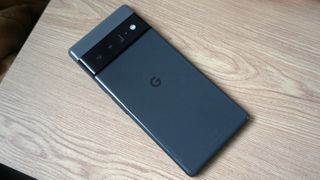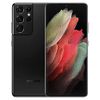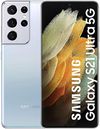
People looking for a new top-end phone will be comparing the Google Pixel 6 Pro vs the Samsung Galaxy S21 Ultra to see which is best for them.
The Google Pixel 6 Pro arrived towards the end of 2021, providing a two-tone full stop at the end of a busy year for flagship phones, with lots of changes to our list of the best smartphones.
That year started, of course, with the launch of the Samsung Galaxy S21 Ultra. It was a formidable tone setter that most subsequent rival releases have failed to match.
Does the Google Pixel 6 Pro fare any better? That’s what we’re here to find out. Now that we’ve had some time with Google’s latest premium phone, we’re in the privileged position to call a clear winner.
Google Pixel 6 Pro vs Samsung Galaxy S21 Ultra price and availability
The Pixel 6 Pro landed on October 28. Prices start from $899 / £849 / AU$1,299 for the 128GB model. There’s also a 256GB variant and a 512GB for some color variations.
The Samsung Galaxy S21 Ultra arrived way back on January 29, 2021. Prices start at $1,199 / £1,149 / AU$1,849 for the 128GB model. The 256GB model costs $200 / £200 / AU$300 more, and the 512GB model represents another such bump.
Even taking into consideration the Galaxy S21 Ultra’s age, and the fact that you can probably find a tasty deal for one right now, it’s clear that the Pixel 6 Pro is the cheaper device of the two.
Get daily insight, inspiration and deals in your inbox
Sign up for breaking news, reviews, opinion, top tech deals, and more.
Google Pixel 6 Pro vs Samsung Galaxy S21 Ultra: Design
At 165.1 x 75.6 x 8.9mm and 228g, the Samsung Galaxy S21 Ultra is one of the heftier handsets on the market. The Pixel 6 Pro pushes it quite close, though, at a very similar 163.9 x 75.9 x 8.9mm and 210g.
Both phones have their own distinctive look, which we appreciate. The Samsung Galaxy S21 Ultra was an early contender for smartphone design of the year. That was easy to say when it was virtually the FIRST phone of the year, of course, but its looks have held up remarkably well.
Its swooping camera module remains a Samsung signature, while the matte Phantom Black finish of our review unit remains a stealthy favorite.


The Pixel 6 Pro, on the other hand, goes with a striking two-tone approach, splitting the color palette between the top strip and the main rear panel.
Bisecting these is Google’s take on the oversized camera module, which isn’t as subtle or flowing as Samsung’s. Still, its full-width nature ensures that you don’t get any rocking when you lay the phone down flat, which is a bonus.
Both phones pack an IP68 rating, which you’d expect in any genuine flagship phone these days, and both also feature Corning Gorilla Glass Victus to front and back, sandwiching aluminum frames. Both have slightly curved displays, too.
We’d perhaps give the Galaxy S21 Ultra the edge here in terms of looks. It might be heavier, but its design is less divisive and more flowing than its in-your-face Pixel 6 Pro brother.
Google Pixel 6 Pro vs Samsung Galaxy S21 Ultra: display
This is a close-run thing. Both phones pack large, sharp OLED displays with rapid 120Hz refresh rates.
The Samsung Galaxy S21 Ultra screen is slightly larger at 6.8-inches. But the difference is negligible, with the Pixel 6 Pro screen measuring 6.71-inches.
Both OLEDs are capable of running at a 120Hz refresh rate and a Quad HD resolution at the same time. And both employ LTPO technology to scale that refresh rate according to the task, thus saving battery life.
With a claimed peak brightness of 1,500 nits, the Galaxy S21 Ultra would appear to be able to get much brighter than the 800 nits of the Pixel 6 Pro. In most day-to-day conditions, both appear to be plenty bright enough, but the Samsung will likely have the edge in those extreme sunny day scenarios.
We’d perhaps give Samsung the edge when it comes to its fingerprint sensor implementation, too. With a 1.7X increase in size over previous Samsung phones, it’s much easier to hit than before.
By contrast, we found the Pixel 6 Pro’s fingerprint sensor to be a little tricky to hit consistently.
Google Pixel 6 Pro vs Samsung Galaxy S21 Ultra: cameras

Both of these phones go big on the camera hardware. The Samsung’s quad-sensor system is led by a huge 1/1.33" 108MP wide sensor with an f/1.8 aperture.
Google goes with a chunky 1/1.31-inch 50MP wide sensor accompanied by an f/1.85 aperture. This means that the Pixel 6 Pro technically produces bigger pixels (1.2µm vs 0.8µm), but both cameras employ pixel-binning techniques, so such a comparison isn’t particularly useful.
Both phones go with 12MP f/2.2 ultra-wide sensors, though Samsung’s captures larger 1.4µm pixels (versus 1.25µm in the Pixel 6 Pro).
These two camera systems diverge further with their telephoto offerings. Google goes with a single 48MP sensor and a 4x optical zoom. Samsung goes with a pair of 10MP sensors, one with a 3x optical zoom lens, and the other with a 10x zoom.
There’s really no contest when it comes to zoomed-in shots, with Samsung taking the ‘best telephoto’ title. The ultra-wides are nip and tuck, as you’d expect, while the main sensors each have their perks and quirks.
Google has given the Pixel 6 Pro some intriguing new software tricks, powered by the company’s custom Tensor chip. Magic Eraser is the most striking, at least when it works properly. At its best, you can tap to instantly remove unwanted background elements.
As always with two great camera phones, much of which you prefer may come down to personal preference with regards to the color science. Samsung goes with super vibrant, punched up colors, while Google tends to go cooler and more contrasty.
The Galaxy S21 Ultra has a more pixel-packed 40MP selfie camera compared to the Pixel 6 Pro’s 11.1MP equivalent. But both take decent enough self shots.
Google Pixel 6 Pro vs Samsung Galaxy S21 Ultra: specs and performance

Both of these phones run on custom hardware - or at least, the Pixel 6 Pro and the global version of the Galaxy S21 Ultra do. In the US and China, Samsung goes with an off-the-shelf Snapdragon 888.
Otherwise, the Pixel 6 Pro is the first phone to run on Google’s new Tensor chip, while the Galaxy S21 Ultra packs Samsung’s Exynos 2100 SoC.
In our Geekbench 5 benchmark tests, the Pixel 6 Pro scored an average multi-core score of 2760. That’s some way short of the Samsung Galaxy S21 Ultra’s 3440.
Practically speaking, however, we can’t really separate the two. Both phones feel fast in everyday usage, and both run all of the usual apps and games at top speeds.
Google’s choice of the Tensor chip isn’t so much related to pure processing grunt, anyway. The chip’s machine learning capabilities enable the elaborate camera tricks we mentioned above.
One thing the Galaxy S21 Ultra definitely has more of is storage options. Disappointingly, the Pixel 6 Pro only gives you 128GB and 256GB options in the UK and US. The Galaxy S21 Ultra adds a 512GB option on top of those, and not only in Australia.
The Galaxy S21 Ultra also packs support for Samsung’s signature S Pen stylus. Combined with Samsung’s powerful Notes and PENUP apps, it’s a great tool for taking notes and sketching.
Google Pixel 6 Pro vs Samsung Galaxy S21 Ultra: software
It’s worth mentioning the differing approach to software here. The Pixel 6 Pro comes with pure Android 12, with its bold Material You UI adding a splash of color and design sharpness. We particularly like the way it changes the palette of the entire system to match your chosen wallpaper.
Samsung’s One UI, as vastly improved as it may be over earlier versions, simply can’t compete for aesthetic appeal or sheer cohesiveness. There’s that eternal compromise of two distinct UI visions (and app provisions, and assistants) coexisting in one space. The Pixel 6 Pro feels lighter and more honed as a result.
The Pixel 6 Pro is also guaranteed to receive three full software updates, which we highly doubt the Galaxy S21 Ultra will. Even if it did, one of those would be taken up in the move from Android 11 to Android 12, so the Pixel is ahead on software.
Google Pixel 6 Pro vs Samsung Galaxy S21 Ultra: battery
Both of these phones cram in large 5000 mAh batteries. That’s good to see, given their larger 120Hz displays and powerful processors.
We wouldn’t say that either phone has amazing stamina, however. The Galaxy S21 Ultra’s battery life fits the description “solid”, able to get through a full day of moderate usage without giving out - at least when set to 1080p/120Hz. Things get hairier with QHD engaged.
Meanwhile, we described the Pixel 6 Pro’s battery life as “one of the weaker elements” of the phone. Again, it will last you a day of typical usage, but pushing it hard will see you struggling. It wasn’t uncommon for our reviewer to get to the end of a day with just 10% left in the tank.
Neither phone particularly impresses when it comes time to recharge, either. The Pixel 6 Pro has the slight edge with 30W charging support to the Galaxy S21 Ultra’s 25W. But rivals such as OnePlus and Xiaomi give you 65W and beyond.
Those rivals also deign to give you a charging brick in the box, whereas neither Google or Samsung do.
Google technically wins on the wireless charging front, with support for 23W charging, though that’s only with Google’s own special (and expensive) Pixel Stand. Otherwise, it’s plain old 12W, which actually falls short of the Galaxy S21 Ultra’s 15W.
Takeaway
In the Pixel 6 Pro, Google has produced its first genuinely top tier phone. Its distinctive design, pure Android 12 software, and capable camera all mark it out as a top contender.
Has it wowed us in the same way that the Samsung Galaxy S21 Ultra did at the turn of the year, though? No, not really. Samsung’s phone feels a little tighter and more cohesive, the culmination of years of iterative improvements.
Of course, you might expect as much given the Galaxy S21 Ultra’s price. Even so far on from its January 2020 release, it’s still selling for quite a bit more money than the brand spanking new Pixel 6 Pro.
For its sheer value, then, as well as the elegance of its software, the Pixel 6 Pro might be a more appealing bet for certain users, even if we can’t in all honesty call it the better phone.
- Take a look at all the other best smartphones
You might also want to check out the Samsung Galaxy S21 vs Samsung Galaxy S20 comparison.






